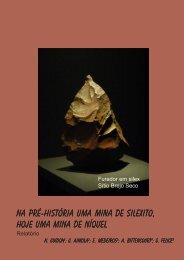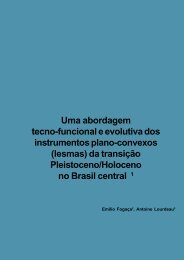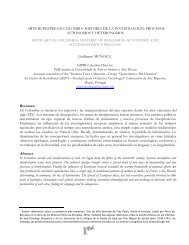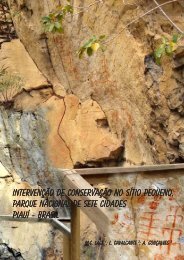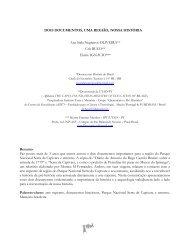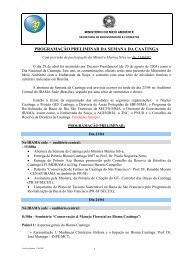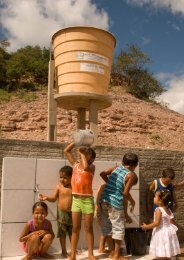Untitled - Fundação Museu do Homem Americano
Untitled - Fundação Museu do Homem Americano
Untitled - Fundação Museu do Homem Americano
Create successful ePaper yourself
Turn your PDF publications into a flip-book with our unique Google optimized e-Paper software.
Global Rock Art Congress<br />
29 Junho – 3 de Julho 2009<br />
12 - Estética e arte rupestre<br />
Esthetics and rock art<br />
Esthéthique et art rupestre<br />
Estética y arte rupestre<br />
Coordena<strong>do</strong> por / Coordinated by: Thomas Heyd, John Clegg &Livio<br />
Dobrez<br />
PAPERS<br />
(Artigo 48 IFRAO2009)<br />
Framing and the Organization of Space in Representation<br />
Livio Dobrez , Austrália<br />
The paper argues that a discussion of the frame is highly relevant to rock art studies and has the added<br />
benefit of linking such studies to the discipline of art history. The frame, which need not be material but<br />
may be purely conceptual, functions differentially to isolate a representation from its surroundings so as<br />
to generate activity within the representation. This happens differently in three types of representation<br />
referred to respectively as narrative-dynamic, hieratic-performative and “surface effect”. On the basis<br />
of the distinction between empirical, lived and representational space, the paper analyses space as<br />
constituted within representations of different kinds and also as organized around representations. It<br />
adds remarks about the operation of space in three-dimensional representations and also about the<br />
historical development of the material frame, including its modification in contemporary (“postmodern”)<br />
art, pointing out the implications of this development for traditional Kantian aesthetics.<br />
59<br />
(Artigo 49 IFRAO2009)<br />
La Estética del Ser-En-El-Espacio: Exploran<strong>do</strong> Más Allá de La Materialidad del Arte Rupestre<br />
en el Norte Semiari<strong>do</strong> de Chile<br />
Andrés Troncoso, Chile<br />
La conformación estética ha esta<strong>do</strong> indisolublemente unida a la materialidad de los objetos y su<br />
percepción, reproducien<strong>do</strong> una dicotomía entre objeto/sujeto-naturaleza/cultura propia a Occidente.<br />
En arte rupestre, como bien ha si<strong>do</strong> ya menciona<strong>do</strong>, no podemos excluir sus espacios de inserción<br />
como referente significativo para la comprensión de esta materialidad. En este trabajo, a partir de la<br />
definición del concepto de arquitectura imaginaria, proponemos que la conceptualización estética del arte<br />
rupestre se establece a partir de una relación dialógica entre un conjunto de elementos que traspasan<br />
la oposición naturaleza/cultura, tales como son: rocas con graba<strong>do</strong>s, rocas sin graba<strong>do</strong>s, espacios con<br />
rocas, espacios sin rocas, campos de visibilidad y otros. A partir de su sintaxis, el arte rupestre promueve<br />
una experiencia espacial anclada en la estética del ser-en-el-espacio. Esta proposición se explora a<br />
partir de la discusión de un caso de estudio en el Norte Semiari<strong>do</strong> de Chile.<br />
(Artigo 50 IFRAO2009)<br />
Parque Nacional Serra da Capivara<br />
Piauí, Brasil




